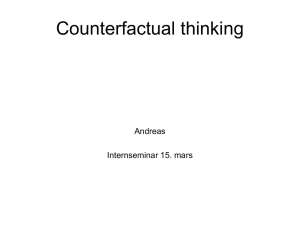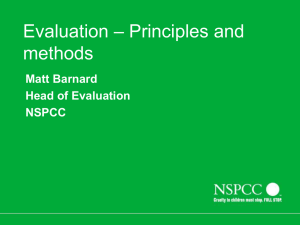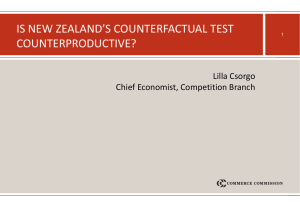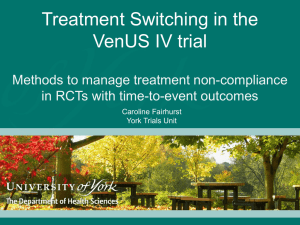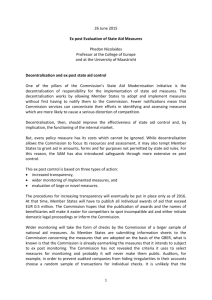The Impact of Counterfactual Mindset on Consumer Information
advertisement
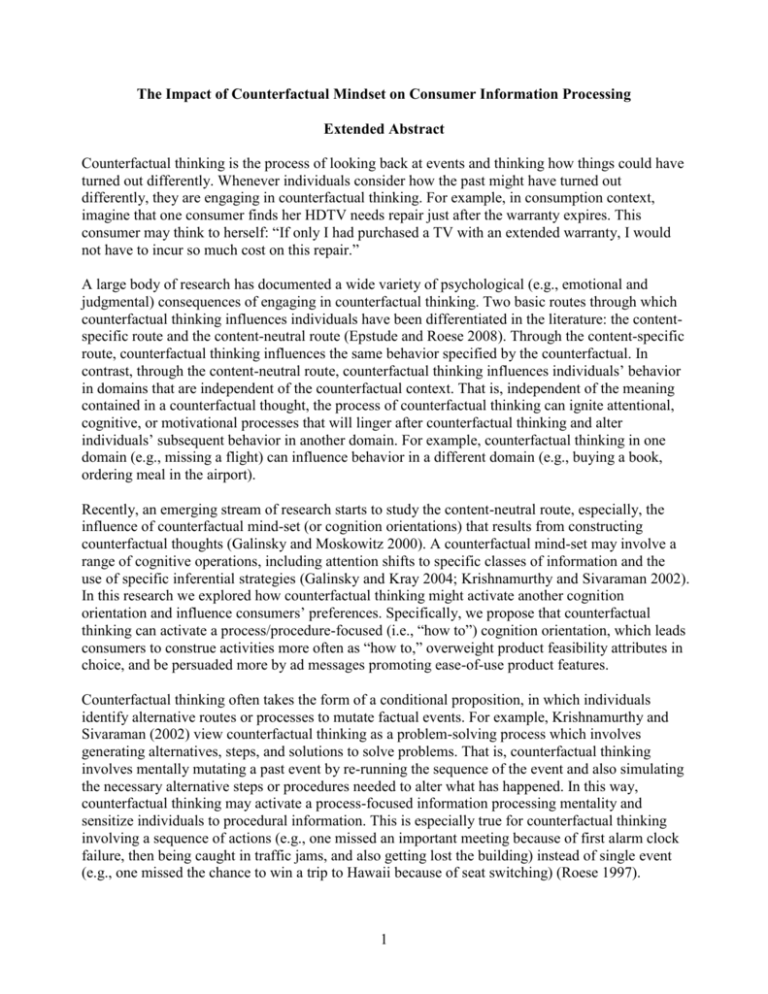
The Impact of Counterfactual Mindset on Consumer Information Processing Extended Abstract Counterfactual thinking is the process of looking back at events and thinking how things could have turned out differently. Whenever individuals consider how the past might have turned out differently, they are engaging in counterfactual thinking. For example, in consumption context, imagine that one consumer finds her HDTV needs repair just after the warranty expires. This consumer may think to herself: “If only I had purchased a TV with an extended warranty, I would not have to incur so much cost on this repair.” A large body of research has documented a wide variety of psychological (e.g., emotional and judgmental) consequences of engaging in counterfactual thinking. Two basic routes through which counterfactual thinking influences individuals have been differentiated in the literature: the contentspecific route and the content-neutral route (Epstude and Roese 2008). Through the content-specific route, counterfactual thinking influences the same behavior specified by the counterfactual. In contrast, through the content-neutral route, counterfactual thinking influences individuals’ behavior in domains that are independent of the counterfactual context. That is, independent of the meaning contained in a counterfactual thought, the process of counterfactual thinking can ignite attentional, cognitive, or motivational processes that will linger after counterfactual thinking and alter individuals’ subsequent behavior in another domain. For example, counterfactual thinking in one domain (e.g., missing a flight) can influence behavior in a different domain (e.g., buying a book, ordering meal in the airport). Recently, an emerging stream of research starts to study the content-neutral route, especially, the influence of counterfactual mind-set (or cognition orientations) that results from constructing counterfactual thoughts (Galinsky and Moskowitz 2000). A counterfactual mind-set may involve a range of cognitive operations, including attention shifts to specific classes of information and the use of specific inferential strategies (Galinsky and Kray 2004; Krishnamurthy and Sivaraman 2002). In this research we explored how counterfactual thinking might activate another cognition orientation and influence consumers’ preferences. Specifically, we propose that counterfactual thinking can activate a process/procedure-focused (i.e., “how to”) cognition orientation, which leads consumers to construe activities more often as “how to,” overweight product feasibility attributes in choice, and be persuaded more by ad messages promoting ease-of-use product features. Counterfactual thinking often takes the form of a conditional proposition, in which individuals identify alternative routes or processes to mutate factual events. For example, Krishnamurthy and Sivaraman (2002) view counterfactual thinking as a problem-solving process which involves generating alternatives, steps, and solutions to solve problems. That is, counterfactual thinking involves mentally mutating a past event by re-running the sequence of the event and also simulating the necessary alternative steps or procedures needed to alter what has happened. In this way, counterfactual thinking may activate a process-focused information processing mentality and sensitize individuals to procedural information. This is especially true for counterfactual thinking involving a sequence of actions (e.g., one missed an important meeting because of first alarm clock failure, then being caught in traffic jams, and also getting lost the building) instead of single event (e.g., one missed the chance to win a trip to Hawaii because of seat switching) (Roese 1997). 1 In consumption context, the mindset of focusing on processes or procedural relationships created through counterfactual thinking will increase consumers’ ability to perceive, understand, and valuate product ease-of-use or product feasibility in judgment and choice. Product feasibility, in addition to desirability, is a prominent consideration of consumer choices. Many times consumer decision making involves a trade-off between these two product attributes (Zhao, Hoeffler, Zauberman 2007). Several moderating conditions for consumers’ preference for product feasibility and desirability have been identified in the literature, e.g., product trial experience, decision time distance, decision stage, etc. (Hamilton and Thompson 2007; Rothman 2000; Trope and Liberman 2000). We propose that consumers’ preference for product feasibility and desirability will be moderated by counterfactual thinking (vs. control). Specifically, consumers’ preference for product feasibility will be boosted after going through counterfactual thinking in an unrelated domain. We conducted three experiments to test our hypotheses. In Study 1, we examined how counterfactual thinking (vs. control) impacts the way in which individuals construe activities. 124 participants were randomly assigned to either a control condition or a counterfactual thinking group. Participants in the counterfactual thinking group were instructed to engage in counterfactual thinking with a standard procedure borrowed from the literature. Then, all the participants completed the Behavior Identification Form (BIF). The BIF, a 25-item, dichotomous-response questionnaire, assesses individual differences in level of action identification. For each item, participants read about an action (e.g., “voting”) and circled which of two identifications more appropriately described it. The choices corresponded to “how to” (i.e., procedural) identifications (e.g., “marking a ballot”) and ends identifications (e.g., “influencing the election”). A one-way ANOVA on the total number of “how to” identifications revealed a significant main effect for counterfactual thinking such that individuals gone through counterfactual thinking had a higher total number of “how to” identifications (M = 5.75) than the control group (M = 4.70, F (1, 122) = 6.52, p < .05). In Study 2, we employed a 2 (counterfactual thinking vs. control) x 2 (high-desirability and lowfeasibility product vs. low-desirability and high-feasibility product) between subject factorial design to study how counterfactual thinking will impact consumer choices of product that are presented either in terms of product feasibility or desirability. A total 171 students participated in the study. The counterfactual scenario was modeled after the literature (Roese 1997). The scenario asked the participants to imagine that they experienced a broken camera on a beach during a vacation and later found out that the camera was broken because the camera was left on the beach too long and the battery was damaged. After reading the scenario, participants were asked to complete a series of “If only ______” counterfactual thinking sentences. The control group read the same scenario without going through counterfactual thinking and only wrote down their thoughts that went through their minds as they read the story. Then, participants read a product review from the CNET about MP3 voice recorder. The high-desirability and low-feasibility product was rated high on desirability attributes (e.g., recording quality, overall rating); whereas the high-feasibility and lowdesirability product was rated high on feasibility (e.g., ease of use, quick to set up). Two-way ANOVAs revealed a significant two-way interaction between the two factors (F (1, 167) = 5.30, p < .05). Further analyses showed that individuals gone through counterfactual thinking indicated higher intentions to choose the high-feasibility and low-desirability option (M = 4.79) than the highdesirability and low-feasibility option (M = 4.09, t = 2.43, p < .05). There was no difference in the 2 control condition. Similar results were found on other dependent measures including likelihood to buy and product attitude. In Study 3, we seek to replicate the finings in Study 2 in persuasion context to further explore the role of counterfactual thinking on consumer information processing. It was a two-factor between subject factorial: 2 (counterfactual thinking vs. control) x 2 (ad promoting feasibility attributes vs. ad promoting desirability attributes). A total of 136 students participated in the study. A similar procedure was used to manipulated counterfactual thinking, but with a scenario about missing an important interview. Then participants were shown two digital camera ads promoting a pseudo brand. One ad had a headline of “An Easy Way to Capture Important Moments!” and highlighted the feasibility attributes of the camera (e.g., easy to frame and shoot pictures and videos, automatic face detection, etc.); the other ad had a headline of “An Perfect Camera for Important Moments!” and highlighted the desirability attributes of the camera (e.g., large LCD, true HD quality, etc). Two-way ANOVAs revealed a significant two-way interaction between the two factors on intention to use (F (1, 132) = 5.60, p < .05). Further analyses showed that, for individuals gone through counterfactual thinking, they indicated higher intentions to use the camera after reading the ad promoting feasibility attributes (M = 5.02) than the ad promoting desirability attributes (M = 3.84, t = 2.68, p < .01). The two ads were equally persuasive in the control condition (t = .67, p = .51). Similar results were found on other dependent measures including likelihood to buy and product attitude. Taken together, these three experiments support our proposed theorizing that consumers’ preference for product feasibility will be boosted after going through counterfactual thinking in an unrelated domain. 3 References Bagozzi, Richard P. and Utpal M. Dholakia (1999), “Goal setting and goal striving in consumer behavior,” Journal of Marketing, 63, 19-32. Beck, S. R., Robinson, E. J., Carroll, D.J., & Apperly, I. A. (2006), “Children’s thinking about counterfactuals and future hypotheticals as possibilities,” Child Development, 77, 413-426. Epstude, Kai and Neal J. Roese (2008), “The Functional Theory of Counterfactual Thinking,” Personality and Social Psychology Bulletin, 12 (2), 168-192 Galinsky, A. D., & Kray, L. J. (2004), “From thinking about what might have been to sharing what we know: The effects of counterfactual mind-sets on information sharing in groups,” Journal of Experimental Social Psychology, 40, 606–618. Galinsky, A. D., & Moskowitz, G. B. (2000), “Counterfactuals as behavioral primes: Priming the simulation heuristic and consideration of alternatives,” Journal of Experimental Social Psychology, 36, 257–383. Gilovich, T., Wang, R. F., Regan, D., & Nishina, S. (2003), “Regrets of action and inaction across cultures,” Journal of Cross-Cultural Psychology, 34, 61-71. Hamilton, Rebecca W. and Debora V. Thompson (2007), “Is there a Substitute for Direct Experience? Comparing Consumers’ Preferences After Direct and Indirect Product Experiences,” Journal of Consumer Research, 34 (December), 546-555. Krishnamurthy, Parthasarathy and Anuradha Sivaraman (2002), “The Impact of Counterfactual Thinking on Processing of Subsequently Encountered Stimuli”, Journal of Consumer Research, 28 (March), 650-658. Liberman, N., & Trope, Y. (1998), “The role of feasibility and desirability considerations in near and distant future decisions: A test of temporal construal theory,” Journal of Personality and Social Psychology, 75, 5-18. Markman, K. D., & McMullen, M. N. (2003), “A reflection and evaluation model of comparative thinking,” Personality and Social Psychology Review, 7, 244–267. Rothman, Alexander J. (2000), “Toward a theory-based analysis of behavioral maintenance,” Health Psychology, 19, 64-69. Roese, Neal J. (1997), “Counterfactual thinking,” Psychological Bulletin, 121, 133-148. Trope, Y., & Liberman N. (2000), “Temporal construal and time-dependent changes in preference,” Journal of Personality and Social Psychology, 79, 876-889. Vallacher, R. R., & Wegner, D. M. (1989), “Levels of personal agency: Individual variation in action identification,” Journal of Personality and Social Psychology, 57, 660-671. Zhao, Min, Steve Hoeffler, and Gal Zauberman (2007), “Mental Simulation and Preference Consistency over Time: The Role of Process- Versus Outcome-Focused Thoughts,” Journal of Marketing Research, 44 (2), 379-388. 4

